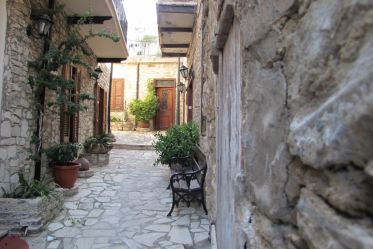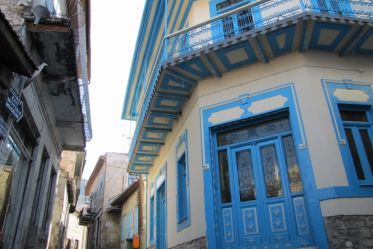![]() +357 24 828 100
+357 24 828 100
![]() +357 24 828 100
+357 24 828 100
Lefkara is where the Cypriot folk needlecraft art is born - the famous “lefkaritiko” - which the reputation of has gone beyond the frontiers of Cyprus and has become known in most of the European countries but not only there. Lefkara owes its welfare and prosperity as always spotted to this needlecraft art and to its trade launched in the late 19th century, flourishing during the 20th century first thirty years.
The name of Lefkara village derives from the colour of the surrounding calcareous rocks: “White rocks = Lefkara”. Considering the archaeological findings, the Lefkara region has most probably been inhabited for centuries. Though there is not any relevant evidence, the settlement is likely to have progressively been established and has developed reaching its current status during the Arab raids between the 7th and 9th century A.D. The inhabitants of the island were forced by the situation due to the raids to move from the coastal areas where they were living in this period to the inland ones, looking for safer places to settle.
However, the very first written historical statement about Lefkara is brought out in Cypriot big type letters: Saint Neophytos the Recluse, who was born in Lefkara in 1134, according to the information provided by him.
During the occupation period by the Franks, Lefkara became the see of the Greek Orthodox Bishop of Limassol, Amathus and Curium and was one of the four Orthodox Bishops’ sees. This occurred following a papal decision according to which the Cyprus Church administration should be placed under the jurisdiction of the Latin Archbishop resulting to the Greek Orthodox Bishops being forced to abandon their sees in the cities and settle in the rural areas.
Later Lefkara during the occupation period by the Venetians (1489 - 1570 A.D.) is referred to as a summer resort for the Venetian nobles and their families. According to some researchers, the Lefkara needlecraft known as “lefkaritiko” goes back to this period and the nobles’ wives influenced to some extent the technique used by the Lefkara women.
Furthermore, it is said that Leonardo da Vinci, the big Renaissance artist visited Cyprus in the late 16th century as a guest of Catherine Cornaro - Queen of Cyprus. He then visited Lefkara and bought a big tablecloth embroidered on all sides, which was donated to the Milan Cathedral.
Timios Stavros Church
The magnificent Lefkara Church is dedicated to the Holy Cross and dates back to the 14th century. According to the byzantinologist Athanasios Papageorgiou the eastern part of the Church dates back to the 14th century, namely after considering rescued frescoes behind the church’s iconostasis. This date is also confirmed by the metrical “Olivianos’ inscription”, which appears at the bottom of the Lefkara Golden Cross. There is written evidence that Olivianos was a Lefkara Bishop in 1307 during the occupation period by the Franks. This fact is also confirmed undeniably by the founder’s note on a manuscript dating back to the 14th century, which is kept in the Church’s safe. At the end of this manuscript, which is a precious Evangeliary it is noted that it was written in 1345/46 and that the monk Gabriel who was the abbot and the founder of the “Holy and Life-giver Revealed Cross” monastery paid all the expenses. In 1740 the church was restored and the wooden sculptured iconostasis was then made by the Rhodian sculptor Hadjikyriacos who was called in by the church-warden Lourentzos to this end.
An inscription at the bottom of the icon of the Deposition of Christ gives evidence that in 1761 the iconostasis was gold-plated and the then Kition Bishop Makarios attended the ceremony on this occasion.
In 1857 the magnificent bell-tower of the Church, the bells of which were donated by devout Christian people from Lefkara living abroad, was constructed.
In 1867 important works were carried out in the church and it was, therefore, expanded in order to have a greater congregation capacity. In 1909 common repair works in the church were deemed necessary and then the entrance was constructed as it appears today. The south door was also built. In 1953 the dome was covered with paintings. The style of the eastern part of the church is cruciform with a cupola, while the style of its more recent part is Cypriot dating back to the 19th century. Furthermore, there are six internal pillars ranged in two rows per three pillars.
The exceptional art portable icon of the Deposition of Christ dating back to 18th century
The silver Cross
The iconostasis has an invisible cavity. It is the crypt where the big wooden Cross is kept, which the church is dedicated to. According to tradition, a piece of the Cross of the Lord is contained in the centre of this cross. The Cross is entirely thin silver sheet coated. Fourteen embossed depictions from the Lord’s life, angels and the Is Apostles Constantine and Helena can be seen on the front main facet. The representation of the crucifixion is overlooking in the centre and is covered by the two side doors, which Theotokos (the Mother of God) and Ioannis (John) are represented on. This representation is surrounded by four angels. Constantine the Great, the “Betrayal of Jesus”, “Golgotha” and Saint Helena are illustrated in a row horizontally on the Cross. “The Throne of the Second Coming” and the “Resurrection of Jesus” as well as the representation of the “Deposition” and the “Burial of Jesus” are illustrated in a row vertically on the Cross from top to bottom. Olivianos’ picture with the relevant metrical inscription is illustrated to the far bottom level.
According to tradition, a piece of the Holy and Life-giver Cross of the Lord is contained in the Cross.


